|
Description and Function of the Types of Steel drumsHigh Tenor The high tenor (also known as a soprano pan) is the highest pitched of the steel drums (steel pans) with a pitch range of D4 to F#6, that is, up to two octaves and a major third from D above middle C (C4). Its predecessor actually contained fewer notes which were within the tenor range. However, the name "Tenor" was kept despite the higher range of its descendant, the soprano pan. The notes of this pan is arranged in the cycle of 4ths, going clockwise. 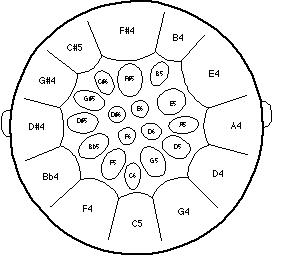
The high tenor pan is a lead instrument and normally carries the melody. However, these steel drums can easily play a harmonic role depending on the desire of the music arranger.The high tenor is commonly used by pan soloists. Low TenorThe Low Tenor, which has a pitch range from C4 to E6 has notes that are arranged in the same order as the high tenor. The function of this steel pan is the same as that of the high tenor and it is also used by pan soloists. 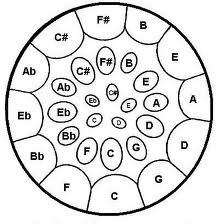
Double Tenor The Double Tenor, which was invented by Bertie Marshall, uses 2 drums and has a pitch range from F3 to B5 or up to two octaves and an augmented 4th from F below middle C. These steel pans have a distinctively pleasant sound, which makes them very appealing to pan soloists. The double tenor can be used to carry the melody, a harmonic voice, for counter melodies or for chords. 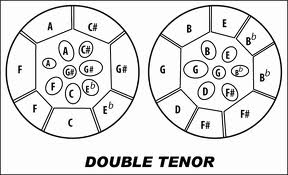
In the latest standardised version of the double tenor steel drums,the Eb note is on the left hand pan and the F# is on the right hand pan. In an earlier version of this pan, the Eb is on the right hand pan and there was no F#3. So you went from F3 to F#4 to G3 and up, which broke the continuity of the range. There is even a double tenor which has the lowest F# (F#3) on the left and the other F#'s on the right, with the Eb also on the right. So, if you decide to play this pan you must be mindful of its variations. The arrangement of the notes on the double tenor is not symmetrical, which makes it one of the more difficult instruments to master. The Double Second PanThis steel pan was invented by Sonny Roach and uses two drums, each of which carries the notes of a whole-tone scale, making it a very symmetrical steel pan. Its notes range from F# below middle C (F#3) up to C#6, which is two octaves above middle C. Because of the symmetry of this pan, the successive notes of the Chromatic Scale alternate between the left and right hand pans. For example, F# is on the left, G is on the right, G# is on the left, and so on... 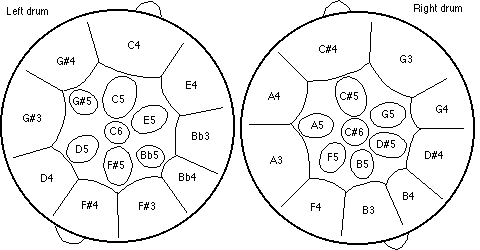
The versatility of the double second steel drums makes them capable of playing lead, harmonic voices, chords (harmony) or counter melody and they are very popular among soloists. They have a very unique (floaty) tonal quality which may be due to the "whole tone" arrangement of the notes of each pan. The sound of the double second steel pan is slightly deeper than that of the double tenor because it has a longer skirt. The Quadrophonic PanThe quadrophonic steel pan uses 4 pans and has an extensive pitch range,from B2 one octave below middle C to Bb5, one octave above. Each pan contains the three notes of an augmented chord, making it a symmetrical pan.The two front pans (2 and 3 in the diagram) are hung in the vertical plane making more physical effort necessary to play it. 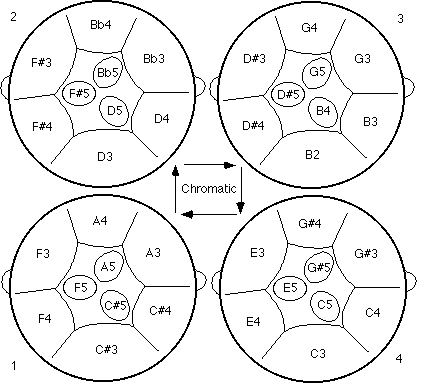
The quadrophonic steel pan can be used to provide harmony,low melodic reinforcement, or for countermelodies. The Guitar PanThe guitar pan uses 2 pans and got its name because it is used mainly for strumming. It is normally used to provide the harmony in a band but it can also be used for counter melody. The range of this steel drum lies from C#3 i.e. one octave below middle C, to F#5 one octave above middle C and note arrangement is similar to that of the double seconds. This steel drum has a mellow and deeper sound due to its longer skirt. 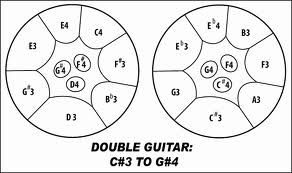
The Cello Pan The Cello Pan uses 3 pans, each of which contains the four notes of a diminished seventh chord. One pan therefore contains the notes C, Eb, Gb and A; another pan contains C#, E, G and Bb; the third pan contains B, D, F and Ab. The range of this pan goes from C3, one octave below middle C to B4 above middle C. The longer skirt and the minor-third relationship between the neighboring notes of each pan gives the cello pans a deep mysterious tonal quality. These steel drums perfect for counter melodies and low harmony. The symmetry of these steel drums allows the chromatic scale to be played in a clockwise pattern between the three pans. Note that the placement of the pans and even the arrangement of the notes within the pans can vary according to the style of the cello pan 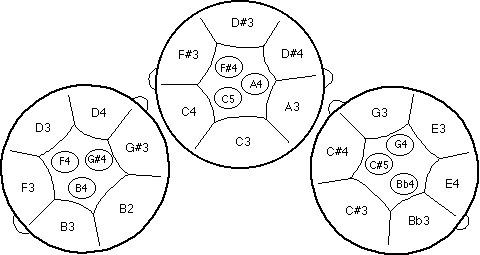
The 4 Pan Bass This bass steel drum is also called a Tenor Bass and uses four drums,each of which contains the notes of an augmented chord. The note arrangement of this steel drum is similar to the quadrophonic steel pan. The range is from G2, two octaves and a 4th below middle C, to D4 above middle C. 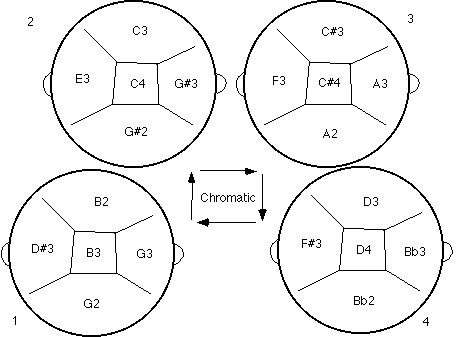
This pan is used to provide the bass function and provides acoustic projection for the lower range bass pans. Other bass pans used are the six-bass (most common), seven bass, nine-bass and less commonly, the twelve-bass. Greater depth is achieved with the inclusion of more drums. However, the function of each type of bass steel pan is the same. A six-bass steel pan chart is shown below. The neighboring note in each of these pans are a 4th apart, thereby giving it some symmetry. 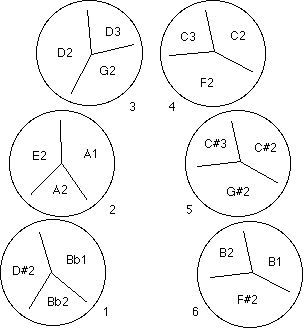
|
